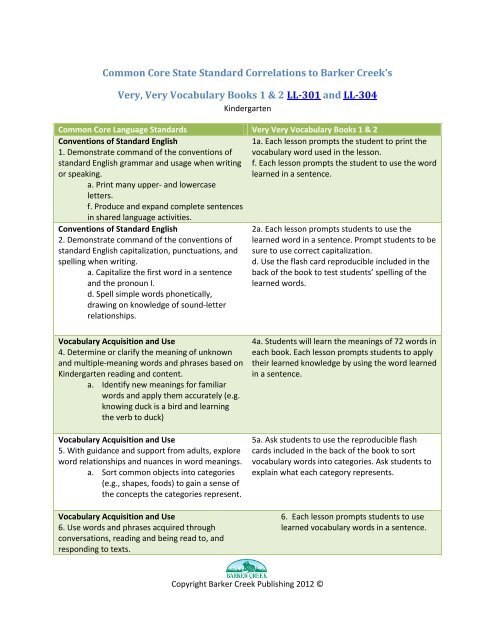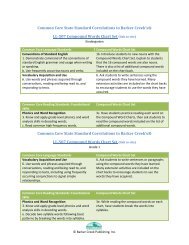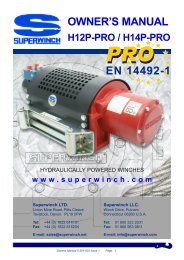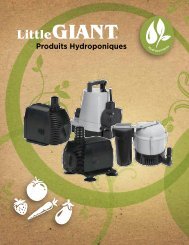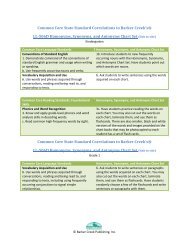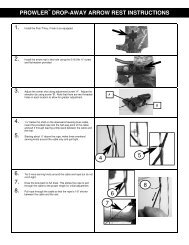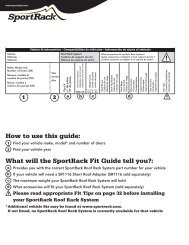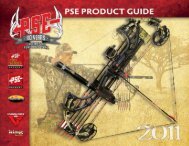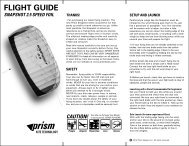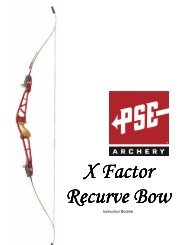Common Core State Standard Correlations to Barker Creek's Very ...
Common Core State Standard Correlations to Barker Creek's Very ...
Common Core State Standard Correlations to Barker Creek's Very ...
You also want an ePaper? Increase the reach of your titles
YUMPU automatically turns print PDFs into web optimized ePapers that Google loves.
<strong>Common</strong> <strong>Core</strong> <strong>State</strong> <strong>Standard</strong> <strong>Correlations</strong> <strong>to</strong> <strong>Barker</strong> Creek’s<br />
<strong>Very</strong>, <strong>Very</strong> Vocabulary Books 1 & 2 LL-301 and LL-304<br />
Kindergarten<br />
<strong>Common</strong> <strong>Core</strong> Language <strong>Standard</strong>s <strong>Very</strong> <strong>Very</strong> Vocabulary Books 1 & 2<br />
Conventions of <strong>Standard</strong> English<br />
1a. Each lesson prompts the student <strong>to</strong> print the<br />
1. Demonstrate command of the conventions of vocabulary word used in the lesson.<br />
standard English grammar and usage when writing f. Each lesson prompts the student <strong>to</strong> use the word<br />
or speaking.<br />
learned in a sentence.<br />
a. Print many upper- and lowercase<br />
letters.<br />
f. Produce and expand complete sentences<br />
in shared language activities.<br />
Conventions of <strong>Standard</strong> English<br />
2. Demonstrate command of the conventions of<br />
standard English capitalization, punctuations, and<br />
spelling when writing.<br />
a. Capitalize the first word in a sentence<br />
and the pronoun I.<br />
d. Spell simple words phonetically,<br />
drawing on knowledge of sound-letter<br />
relationships.<br />
2a. Each lesson prompts students <strong>to</strong> use the<br />
learned word in a sentence. Prompt students <strong>to</strong> be<br />
sure <strong>to</strong> use correct capitalization.<br />
d. Use the flash card reproducible included in the<br />
back of the book <strong>to</strong> test students’ spelling of the<br />
learned words.<br />
Vocabulary Acquisition and Use<br />
4. Determine or clarify the meaning of unknown<br />
and multiple-meaning words and phrases based on<br />
Kindergarten reading and content.<br />
a. Identify new meanings for familiar<br />
words and apply them accurately (e.g.<br />
knowing duck is a bird and learning<br />
the verb <strong>to</strong> duck)<br />
Vocabulary Acquisition and Use<br />
5. With guidance and support from adults, explore<br />
word relationships and nuances in word meanings.<br />
a. Sort common objects in<strong>to</strong> categories<br />
(e.g., shapes, foods) <strong>to</strong> gain a sense of<br />
the concepts the categories represent.<br />
Vocabulary Acquisition and Use<br />
6. Use words and phrases acquired through<br />
conversations, reading and being read <strong>to</strong>, and<br />
responding <strong>to</strong> texts.<br />
4a. Students will learn the meanings of 72 words in<br />
each book. Each lesson prompts students <strong>to</strong> apply<br />
their learned knowledge by using the word learned<br />
in a sentence.<br />
5a. Ask students <strong>to</strong> use the reproducible flash<br />
cards included in the back of the book <strong>to</strong> sort<br />
vocabulary words in<strong>to</strong> categories. Ask students <strong>to</strong><br />
explain what each category represents.<br />
6. Each lesson prompts students <strong>to</strong> use<br />
learned vocabulary words in a sentence.<br />
Copyright <strong>Barker</strong> Creek Publishing 2012 ©
<strong>Common</strong> <strong>Core</strong> <strong>State</strong> <strong>Standard</strong> <strong>Correlations</strong> <strong>to</strong> <strong>Barker</strong> Creek’s<br />
<strong>Very</strong>, <strong>Very</strong> Vocabulary Books 1 & 2 LL-301 and LL-304<br />
Grade 1<br />
<strong>Common</strong> <strong>Core</strong> Language <strong>Standard</strong>s <strong>Very</strong> <strong>Very</strong> Vocabulary Books 1 & 2<br />
Conventions of <strong>Standard</strong> English<br />
1a. Each lesson prompts students <strong>to</strong> print the<br />
1. Demonstrate command of the conventions of vocabulary word used in the lesson.<br />
standard English grammar and usage when writing j. Each lesson prompts the student <strong>to</strong> use the word<br />
or speaking.<br />
learned in a sentence.<br />
a. Print all upper- and lowercase letters<br />
j. Produce and expand complete simple<br />
and compound declarative, interrogative,<br />
imperative, and exclama<strong>to</strong>ry sentences in<br />
response <strong>to</strong> prompts.<br />
Conventions of <strong>Standard</strong> English<br />
2. Demonstrate command of the conventions of<br />
standard English capitalization, punctuation, and<br />
spelling when writing.<br />
d. Use conventional spelling for words<br />
with common spelling patterns and for<br />
frequently occurring irregular words.<br />
Vocabulary Acquisition and Use<br />
5. With guidance and support from adults,<br />
demonstrate understanding of word relationships<br />
and nuances in word meanings.<br />
a. Sort words in<strong>to</strong> categories (e.g., colors,<br />
clothing) <strong>to</strong> gain a sense of the<br />
concepts the categories represent.<br />
b. Define words by category and by one<br />
or more key attributes (e.g, a duck is a<br />
bird that swims; a tiger is a large cat<br />
with stripes)<br />
Vocabulary Acquisition and Use<br />
6. Use words and phrases acquired through<br />
conversations, reading and being read <strong>to</strong>, and<br />
responding <strong>to</strong> texts, including using frequently<br />
occurring conjunctions <strong>to</strong> signal simple<br />
relationships.<br />
2d. Use the reproducible flashcards included in the<br />
back of each book <strong>to</strong> help students practice the<br />
spelling of each vocabulary word.<br />
5a,b. Ask students <strong>to</strong> use the reproducible flash<br />
cards included in the back of the book <strong>to</strong> sort<br />
vocabulary words in<strong>to</strong> categories. Ask students <strong>to</strong><br />
explain what each category represents.<br />
6. Each lesson prompts students <strong>to</strong> use<br />
learned vocabulary words in a sentence.<br />
Copyright <strong>Barker</strong> Creek Publishing 2012 ©
<strong>Common</strong> <strong>Core</strong> <strong>State</strong> <strong>Standard</strong> <strong>Correlations</strong> <strong>to</strong> <strong>Barker</strong> Creek’s<br />
<strong>Very</strong>, <strong>Very</strong> Vocabulary Books 1 & 2 LL-301 and LL-304<br />
Grade 2<br />
<strong>Common</strong> <strong>Core</strong> Language <strong>Standard</strong>s <strong>Very</strong> <strong>Very</strong> Vocabulary Books 1 & 2<br />
Conventions of <strong>Standard</strong> English<br />
1f. Each lesson prompts students <strong>to</strong> use the<br />
1. Demonstrate command of the conventions of vocabulary word learned in a sentence. Ask<br />
standard English grammar and usage when writing students <strong>to</strong> practice expanding & rearranging this<br />
or speaking.<br />
sentence on a separate piece of paper.<br />
f. Produce, expand, and rearrange<br />
complete simple and compound sentences<br />
(e.g., The boy watched the movie; The<br />
little boy watched the movie; The action<br />
moved was watched by the little boy.)<br />
Conventions of <strong>Standard</strong> English<br />
2. Demonstrate command of the conventions of<br />
standard English capitalization, punctuation, and<br />
spelling when writing.<br />
e. Consult reference materials, including<br />
beginning dictionaries, as needed <strong>to</strong> check<br />
and correct spellings.<br />
Vocabulary Acquisition and Use<br />
5. Demonstrate understanding of word<br />
relationships and nuances in word meanings.<br />
a. Identify real-life connections between<br />
words and their use (e.g., describe foods<br />
that are spicy or juicy)<br />
Vocabulary Acquisition and Use<br />
6. Use words and phrases acquired through<br />
conversations, reading and being read <strong>to</strong>, and<br />
responding <strong>to</strong> texts, including using adjectives and<br />
adverbs <strong>to</strong> describe (e.g., When other kids are<br />
happy that makes me happy).<br />
2e. Use the reproducible flash cards in the back of<br />
the book <strong>to</strong> test students’ understanding of the<br />
spelling of each vocabulary word. Ask students <strong>to</strong><br />
practice checking & correcting the spelling of the<br />
vocabulary words using reference materials.<br />
5a. Ask students <strong>to</strong> use the reproducible flash card<br />
included in the back of the book <strong>to</strong> make<br />
connections between different vocabulary words.<br />
6. Each lesson prompts students <strong>to</strong> use learned<br />
vocabulary words in a sentence.<br />
Copyright <strong>Barker</strong> Creek Publishing 2012 ©
<strong>Common</strong> <strong>Core</strong> <strong>State</strong> <strong>Standard</strong> <strong>Correlations</strong> <strong>to</strong> <strong>Barker</strong> Creek’s<br />
<strong>Very</strong>, <strong>Very</strong> Vocabulary Books 1 & 2 LL-301 and LL-304<br />
Grade 3<br />
<strong>Common</strong> <strong>Core</strong> Language <strong>Standard</strong>s <strong>Very</strong> <strong>Very</strong> Vocabulary Books 1 & 2<br />
Conventions of <strong>Standard</strong> English<br />
1. Demonstrate command of the conventions of<br />
standard English grammar and usage when writing<br />
or speaking.<br />
1i. Each lesson prompts students <strong>to</strong> use the<br />
vocabulary word learned in a sentence. Ask<br />
students <strong>to</strong> produce a simple, compound, and<br />
complex sentence using the vocabulary word<br />
i. Produce simple, compound, and<br />
complex sentences.<br />
learned in the lesson.<br />
Conventions of <strong>Standard</strong> English<br />
2. Demonstrate command of the conventions of<br />
standard English capitalization, punctuation, and<br />
spelling when writing.<br />
e. Use conventional spelling for highfrequency<br />
and other studied words<br />
and for adding suffixes <strong>to</strong> base words.<br />
(e.g., sitting, smiled, cries, happiness).<br />
g. Consult reference materials,<br />
including beginning dictionaries, as<br />
needed <strong>to</strong> check and correct spellings.<br />
Vocabulary Acquisition and Use<br />
4. Determine or clarify the meaning of unknown<br />
and multiple-meaning words and phrases based on<br />
grade 3 reading and content, choosing flexibly<br />
from a range of strategies.<br />
d. Use glossaries or beginning dictionaries,<br />
both print and digital, <strong>to</strong> determine or<br />
clarify the precise meaning of key words<br />
and phrases.<br />
Vocabulary Acquisition and Use<br />
6. Acquire and use accurately grade-appropriate<br />
conversational, general academic and domainspecific<br />
words and phrases, including those that<br />
signal spatial and temporal relationships (e.g.,<br />
After dinner that night we went looking for them).<br />
2e,g. Use the reproducible flash cards in the back<br />
of the book <strong>to</strong> test students’ understanding of the<br />
spelling of each vocabulary word. Ask students <strong>to</strong><br />
practice checking & correcting the spelling of the<br />
vocabulary words using reference materials.<br />
4d. Each lesson prompts students <strong>to</strong> use a<br />
dictionary <strong>to</strong> determine the meaning of the<br />
vocabulary word learned in the lesson.<br />
6. Each lesson prompts students <strong>to</strong> use learned<br />
vocabulary words in a sentence.<br />
Copyright <strong>Barker</strong> Creek Publishing 2012 ©
<strong>Common</strong> <strong>Core</strong> <strong>State</strong> <strong>Standard</strong> <strong>Correlations</strong> <strong>to</strong> <strong>Barker</strong> Creek’s<br />
<strong>Very</strong>, <strong>Very</strong> Vocabulary Books 1 & 2 LL-301 and LL-304<br />
Grade 4<br />
<strong>Common</strong> <strong>Core</strong> Language <strong>Standard</strong>s <strong>Very</strong> <strong>Very</strong> Vocabulary Books 1 & 2<br />
Conventions of <strong>Standard</strong> English<br />
1f. Each lesson prompts students <strong>to</strong> use the<br />
1. Demonstrate command of the conventions of vocabulary word learned in a sentence. Ask<br />
standard English grammar and usage when writing students <strong>to</strong> focus on recognizing and correcting<br />
or speaking.<br />
inappropriate fragments and run-ons.<br />
f. Produce complete sentences,<br />
recognizing and correcting inappropriate<br />
fragments and run-ons.<br />
Conventions of <strong>Standard</strong> English<br />
2. Demonstrate command of the conventions of<br />
standard English capitalization, punctuation, and<br />
spelling when writing.<br />
a. Use correct capitalization.<br />
c. Spell grade-appropriate words<br />
correctly, consulting references as<br />
needed.<br />
Vocabulary Acquisition and Use<br />
4. Determine or clarify the meaning of unknown<br />
and multiple-meaning words and phrases based on<br />
grade 4 reading and content, choosing flexibly<br />
from a range of strategies.<br />
c. Consult reference materials (e.g.,<br />
dictionaries, glossaries, thesauruses), both<br />
print and digital, <strong>to</strong> find the pronunciation<br />
and determine or clarify the precise<br />
meaning of key words and phrases.<br />
Vocabulary Acquisition and Use<br />
6. Acquire and use accurately grade-appropriate<br />
general academic and domain-specific words and<br />
phrases, including those that signal precise<br />
actions, emotions, or states of being (e.g., quizzed,<br />
whined, stammered) and that are basic <strong>to</strong> a<br />
particular <strong>to</strong>pic (e.g., wildlife, conservation, and<br />
endangered when discussing animal<br />
preservations).<br />
2a. Each lesson prompts students <strong>to</strong> use the<br />
vocabulary word learned in a sentence. Ask<br />
students <strong>to</strong> focus on making sure they use correct<br />
capitalization during this exercise.<br />
c. Use the reproducible flashcards included in the<br />
back of each book <strong>to</strong> help students practice the<br />
spelling of each vocabulary word. Ask students <strong>to</strong><br />
use references if they need help spelling a word.<br />
4c. Use the reproducible flashcards included in the<br />
back of each book <strong>to</strong> help students practice the<br />
spelling of each vocabulary word.<br />
6. Each lesson prompts students <strong>to</strong> use learned<br />
vocabulary words in a sentence. You may also use<br />
the reproducible flash cards included in the back of<br />
the book and ask students <strong>to</strong> sort the flashcards<br />
in<strong>to</strong> categories.<br />
Copyright <strong>Barker</strong> Creek Publishing 2012 ©
<strong>Common</strong> <strong>Core</strong> <strong>State</strong> <strong>Standard</strong> <strong>Correlations</strong> <strong>to</strong> <strong>Barker</strong> Creek’s<br />
<strong>Very</strong>, <strong>Very</strong> Vocabulary Books 1 & 2 LL-301 and LL-304<br />
Grade 5<br />
<strong>Common</strong> <strong>Core</strong> Language <strong>Standard</strong>s <strong>Very</strong> <strong>Very</strong> Vocabulary Books 1 & 2<br />
Conventions of <strong>Standard</strong> English<br />
2e. Use the reproducible flashcards included in the<br />
2. Demonstrate command of the conventions of back of each book <strong>to</strong> help students practice the<br />
standard English capitalization, punctuation, and spelling of each vocabulary word. Ask students <strong>to</strong><br />
spelling when writing.<br />
use references if they need help spelling a word.<br />
e. Spell grade-appropriate words correctly,<br />
consulting references as needed.<br />
Vocabulary Acquisition and Use<br />
4. Determine or clarify the meaning of unknown<br />
and multiple-meaning words and phrases based on<br />
grade 5 reading and content, choosing flexibly<br />
from a range of strategies.<br />
c. Consult reference materials (e.g.,<br />
dictionaries, glossaries, thesauruses), both<br />
print and digital, <strong>to</strong> find the pronunciation<br />
and determine or clarify the precise<br />
meaning of key words and phrases.<br />
Vocabulary Acquisition and Use<br />
6. Acquire and use accurately grade-appropriate<br />
general academic and domain-specific words and<br />
phrases, including those that signal contrast,<br />
addition, and other logical relationships (e.g.,<br />
however, although, nevertheless, similarly,<br />
moreover, in addition).<br />
4c. Each lesson prompts students <strong>to</strong> use a<br />
dictionary <strong>to</strong> determine the meaning of the<br />
vocabulary word being learned in the lesson.<br />
6. Each lesson prompts students <strong>to</strong> use learned<br />
vocabulary words in a sentence. You may also use<br />
the reproducible flash cards included in the back of<br />
the book and ask students <strong>to</strong> sort the flashcards<br />
in<strong>to</strong> categories.<br />
Copyright <strong>Barker</strong> Creek Publishing 2012 ©


